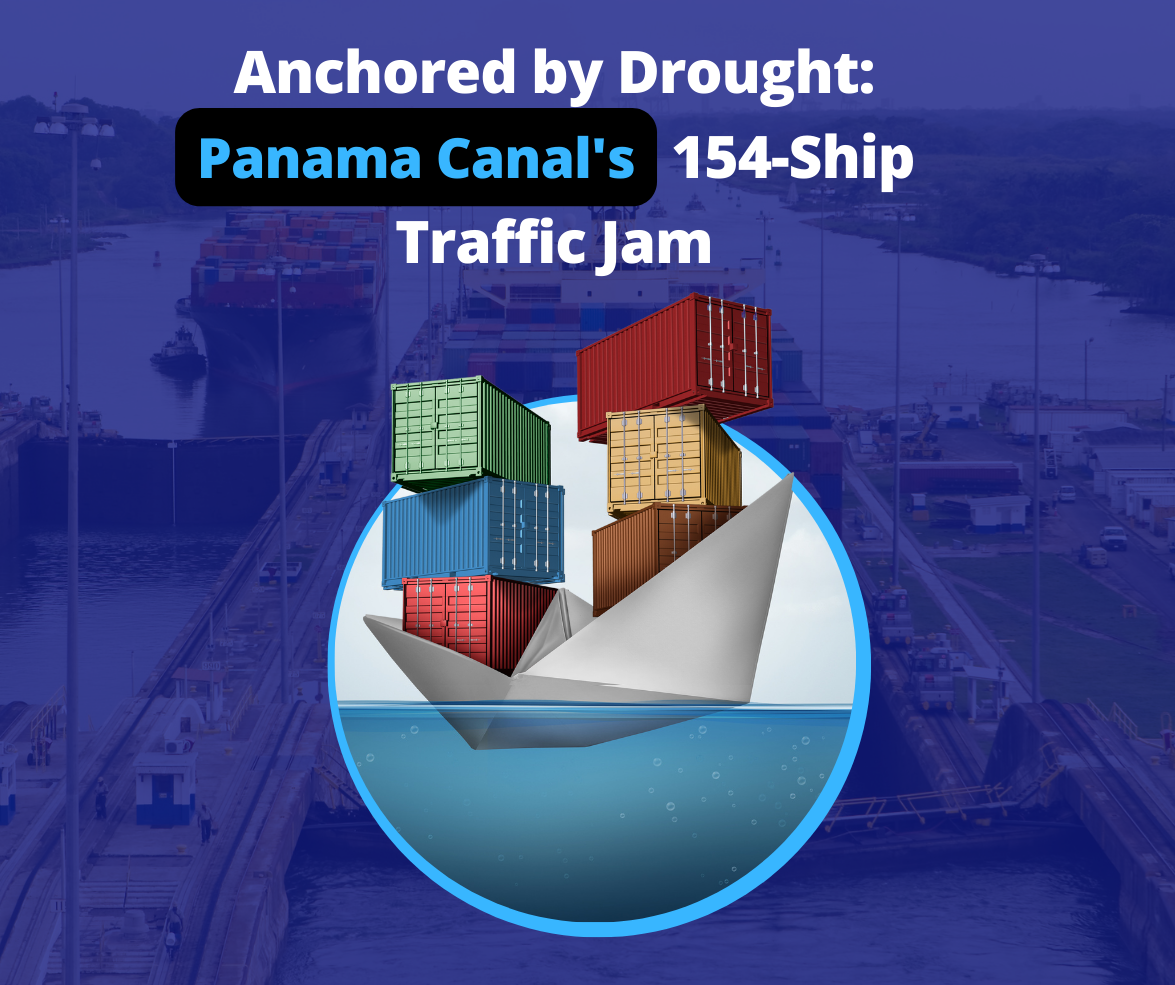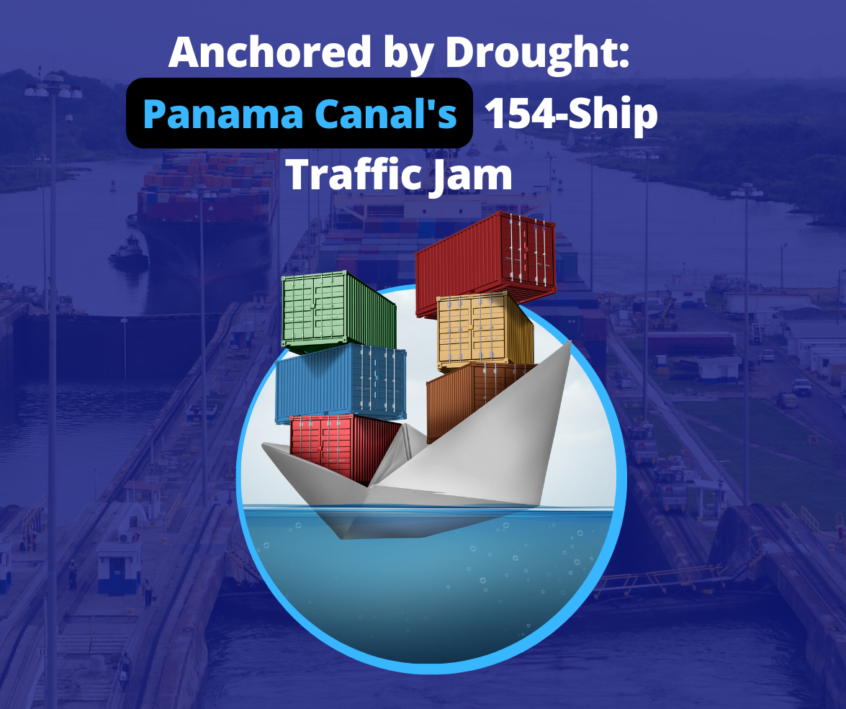
An In-depth Examination of the 154-Ship Traffic Jam
In the intricate web of global trade and interconnected supply chains, disruptions to vital transportation routes can create cascading effects across industries. The Panama Canal, a remarkable feat of engineering linking the Atlantic and Pacific Oceans, historically symbolized seamless trade facilitation. However, the present situation unveils a starkly contrasting reality.
The canal presently grapples with an unparalleled crisis—154 ships are entangled in a traffic jam resulting from a severe and enduring drought. This article explores the nuanced dimensions of the crisis, shedding light on its underlying causes, ramifications, potential resolutions, and the profound implications it bears for the shipping and logistics sectors.
Unraveling the Anatomy of the Crisis
At the core of the Panama Canal crisis is a stark shortage of rainfall, a direct consequence of the ongoing specter of global warming. This shortage of rainwater has led to a notable decline in the water levels of the lakes that supply the essential locks of the Panama Canal. Among these lakes, situated prominently in the Colon province about 50 km north of Panama City, Lake Alajuela is a glaring example of the challenge at hand.
Lake Alajuela holds significant importance for the Panama Canal’s operations as it contributes to maintaining the necessary water levels that allow the canal locks to function efficiently. However, due to the prolonged impact of global warming, the water levels of Lake Alajuela have gradually decreased, creating a critical situation for the canal’s operations.
Broader Themes of Climate Degradation
Lake Alajuela’s situation encapsulates the broader issue of environmental changes under global warming. The diminishing water levels serve as a tangible reminder of the environmental vulnerability caused by human activities. This situation also emphasizes the urgency of addressing the root causes of climate change and implementing measures to ensure a sustainable future.
Regarding the Panama Canal crisis, Lake Alajuela exemplifies the intricate relationship between environmental concerns and economic activities. The lake’s declining water levels have far-reaching consequences that extend beyond its immediate vicinity, impacting industries, economies, and societies connected to the canal’s operations. This underscores the interdependence of human well-being and the health of the natural environment.
As the Panama Canal grapples with this unprecedented challenge, the plight of Lake Alajuela serves as a stark reminder that effective responses to climate change are essential for the canal’s functioning and the broader global community. The situation calls for collective efforts to address the underlying causes of the crisis and work toward sustainable solutions that ensure the well-being of both the canal and the planet.
The significance of these lakes lies in their role in maintaining requisite water levels for the seamless functioning of the canal’s locks. However, these lakes are grappling with their lowest water levels in recent memory. Consequently, the Panama Canal Authority has undertaken extraordinary measures to confront the detrimental impact of this prolonged drought.
Grasping the Gravity of the Situation
Understanding the severity of the Panama Canal crisis requires acknowledging its vital role in global trade, as this waterway is a crucial conduit for about 40% of container goods crossing the Americas, representing a trade value of around $270 billion annually. Beyond its economic impact, the canal expedites supply chains, expands market access, and catalyzes trade dynamics. Consequently, the current traffic congestion and prolonged delays have far-reaching consequences beyond the shipping industry, affecting various sectors worldwide.
The Panama Canal’s significance extends beyond economic numbers. For example, its smooth operation is pivotal for industries to meet consumer demands, sustain production cycles, and ensure efficient global trade. The current crisis reverberates across industries, causing disruptions that can cascade down the supply chain. From manufacturing to retail, sectors relying on timely shipments encounter uncertainties that can lead to shortages, impact market stability, and influence consumer prices. The energy sector, heavily dependent on the canal for transporting resources, also faces potential disruptions that result in fluctuating fuel prices.
In essence, the Panama Canal crisis underscores the intricate interdependence of global trade, impacting maritime traffic and demonstrating how disruptions in one part of the world can trigger a domino effect that reverberates throughout economies and livelihoods worldwide. As efforts are made to alleviate congestion and restore functionality, the crisis serves as a compelling reminder of the modern supply chains’ fragility and the imperative to bolster resilience and adaptability in the face of unforeseen challenges.
The Global Trade Ripple Effect
(i) Economic Repercussions
The accumulation of vessels awaiting their turn to traverse the Panama Canal initiates cascading economic repercussions. Shipping companies bear the brunt of escalating costs as their vessels lie idle, awaiting passage. This financial burden inevitably trickles down the supply chain, potentially triggering shortages and inflation, thus amplifying the economic strain experienced by industries navigating post-pandemic recovery challenges.
(ii) Navigational Course Corrections
As the Panama Canal grapples with congestion, vessels find themselves at a crossroads, necessitating recalibrations of their traditional routes. Two significant alternatives stand before them:
a) South American Circumnavigation: Some vessels opt to circumvent the entirety of South America, choosing a longer, albeit less congested, route.
b) Suez Canal Detour: Alternatively, vessels can opt for the Suez Canal route, which entails extended transit times and elevated fuel consumption.
Consequently, these alternatives disrupt fuel consumption patterns and engender a fundamental shift in supply chain dynamics.
Energy Sector Turmoil
The ongoing crisis has instigated a notable adjustment in the routes chosen by clean tanker vessels as they opt to navigate toward the Atlantic Basin. This strategic pivot, aimed at avoiding the congestion within the Panama Canal, is causing disruptions to well-established supply chains. As a result of this redirection, the potential arises for issues that could trigger fluctuations in fuel prices, impacting the intricate web of global energy markets. This ripple effect has a far-reaching impact as it reshapes the equilibrium dynamics that have traditionally characterized these markets.
The shift in route preferences for clean tanker vessels symbolizes the pragmatic measures industries took to mitigate the challenges posed by the Panama Canal crisis. By opting for the Atlantic Basin, these vessels seek a more streamlined path, free from the congestion and delays plaguing the canal. However, this tactical change has repercussions. For example, the disruption in the established supply chains can set off a chain reaction, potentially leading to fluctuations in fuel prices. Given the interconnected nature of the energy sector, any perturbations in supply routes can reverberate through the global energy landscape, prompting adjustments in pricing and availability.
As clean tanker vessels recalibrate their navigation routes, the repercussions of this strategic shift extend beyond individual shipping decisions. The energy markets, known for their delicate balance, are subject to the influence of even the subtlest changes. The decision to bypass the Panama Canal speaks to the urgency of addressing the current congestion. It also underscores the intricate interplay between global logistics and market dynamics. This shift prompts an examination of the energy sector’s resilience and adaptability in the face of unforeseen challenges and the need for diversified routes to ensure stability in a fast-evolving world.
Authority’s Response and Mitigation Strategies
The Panama Canal Authority has demonstrated proactive responsiveness to the crisis, adopting an array of strategies to mitigate its repercussions. Noteworthy measures include:
Pre-Booking Slot Reduction
A significant tactical maneuver entails reducing pre-booking slots allocated to the largest vessels, colloquially called Panamax vessels. These vessels form the backbone of the canal’s capacity. The decrease in pre-booking slots, reduced from 23 to 14 per day, represents a strategic attempt to manage the flow of vessels through the constrained canal passage.
Transit Capacity Adjustment
In a bid to alleviate the congestion, the daily transit capacity of the Panama Canal has been recalibrated. A once-averaged 34 to 36 vessels per day has since altered to accommodate approximately 32 vessels daily. This adjustment reflects a concerted effort to address congestion by modulating the number of vessels navigating the canal.
Historical Context and Resilience
While the current congestion and backlog gripping the Panama Canal appear unprecedented, historical parallels abound. The crisis evokes memories of analogous situations, such as the 2022 scenario characterized by residual pandemic-induced delays and geopolitical tensions. This historical context underscores the canal’s susceptibility to external shocks and its symbiotic relationship with broader economic and geopolitical trends.
Navigating the Climate and Sustainability Nexus
The Panama Canal crisis is an unambiguous reminder of the intricate interplay between commercial pursuits and environmental stewardship. The traffic impasse triggered by the drought underscores the urgency to tackle climate change and embrace sustainable practices. As industries grapple with the repercussions of disruptions, policymakers face prioritizing environmental sustainability. The call to action encompasses investments in resilient infrastructure, responsible water management strategies, and the seamless integration of sustainable practices into trade frameworks.
Wrapping Up
The Panama Canal crisis emerges as a poignant narrative in a landscape characterized by global interconnectedness and intricate supply chains. The 154-ship traffic jam encapsulates the complex interplay between trade dynamics, environmental dilemmas, and logistical complexities. As vessels languish and industries pivot, the crisis metamorphoses into a profound lesson—an embodiment of adaptability, resilience, and the imperative to harmonize progress with sustainability imperatives. The trajectory forward demands short-term remedies and long-term strategies that shield commerce and the planet. As the Panama Canal grapples with a crisis of unparalleled proportions, it underscores an incontrovertible verity—the pivotal fusion of human enterprise and the rhythms of nature in shaping our shared future.



One Comment on ““Navigating the Panama Canal Crisis: Unraveling the 154-Ship Traffic Jam and Its Global Ramifications””
Thanks for sharing. This is so informative.